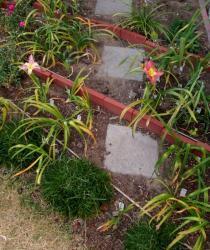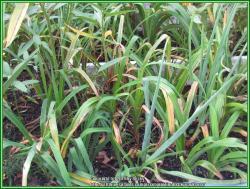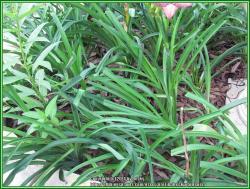Regarding stress and water needs, in my experience and environment, even when optimal water requirements are met in sun-baked heat above 90 degrees, daylilies will undergo much more stress than in shade or partial shade. I'd be interested in learning how, and where, the upper zones divide so that (especially sustained) 90-100 degree temperatures do or don't result in high stress to daylilies, and to see information and pictures that document growing conditions (soil type, humidity, watering styles, etc) and show the difference in results between those environments. Perhaps, also, whether there are differences in practice between commercial (or commercial grade) applications and practices that impact results (spraying, use of chemical treatments, etc.). Whatever ways that rust may be helped or impeded by temperature, environmental or gardening impacts, including trimming, I think there are different results that follow climate/temperature conditions (as there are from cold-stresses in the the lower temps of northern zones).
Focusing of hot temperature impacts, we recently had a heat-wave averaging 105-degrees over three days. Prior to the heat wave, the plant and foliage health in three distinct areas were the same in terms of level of green, and with budding and blooming at comparable rates, soil moisture equally robust within half to an inch of the topsoil, and with only incidental size differences as distinguishing features between foliage and blooms.
Quickly after the heat wave passed, the full sun beds were filled with scorched and highly stressed daylilies (the same as I see every summer once the heat fully commences), while partial shade and deeper shade plants remained unaffected. After doing extensive digging and relocating of daylilies last fall I also learned that after the usual three months at extremely high temps, with as much hydration in the soil as possible during the season, most of the daylilies in beds with full sun exposure had retrograded to a level of juvenile development that required support in a sheltered greenhouse over winter in order to rebound. They are still not back to full-size yet, in terms of foliage and root systems, nor have they flowered this year.
Here are pictures from just after the current heat wave. Again, soil moisture was comparable, as was health, vigor, budding/flowering, etc., immediately prior to the change in temperature, and full sun beds were given supplemental watering as needed during those days.
Deep and partial shade areas:
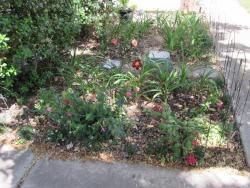

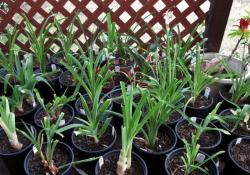
Full sun beds:


